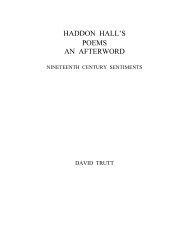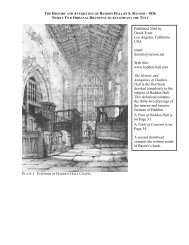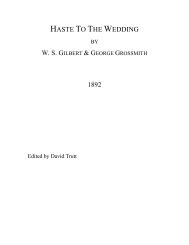Download - Haddon Hall
Download - Haddon Hall
Download - Haddon Hall
You also want an ePaper? Increase the reach of your titles
YUMPU automatically turns print PDFs into web optimized ePapers that Google loves.
32 PART III EARLY HISTORY OF HADDON HALL BY S. RAYNER<br />
The confederates, in comparison with their foes, were but a handful of men, but they<br />
were well armed and disciplined, and inspired with enthusiasm by the exhortation of the<br />
priests, they dreaded but little the assault of their numerous half-naked savage opponents.<br />
The Scottish King advanced to the attack surrounded by his legions. With the prudence of<br />
an able General he would have place his men-at-arms in front; but the fierce Highlanders<br />
and savage Borderers would not be restrained. “I wear no armour,” exclaimed one of their<br />
Chiefs; “but no mailed Knight shall march before me this day.” Thus casting aside all<br />
caution, they rushed to the conflict, despising their enemies on account of the smallness of<br />
their number. But they were received in a very different manner from what they had<br />
expected. Flights of arrows from a distance pierced their un-armed bodies; and when they<br />
came to close quarters, they found that with their weapons they could make no impression<br />
on their steel-clad adversaries, whose blows in return they were utterly unable to<br />
withstand. Yet though thus overpowered and destroyed in crowds, they manifested no<br />
want of courage. For nearly three hours they kept their ground, fresh bands continually<br />
advancing over the bodies of their slain comrades. But finding it vain to contend under<br />
such disadvantages, they at last gave way, and fled in confusion, throwing down their arms<br />
and baggage that they might have nothing to impede their flight. In commemoration of<br />
this last ignominious circumstance, the field of battle was afterwards called Baggamor.<br />
King David and his Knights endeavoured to maintain the combat, but in vain; they<br />
were obliged to consult their safety by flight. The wretched remaining survivors of the<br />
Scottish army sought concealment in woods, brakes, and marshes, where many of them<br />
perished in consequence of their wounds, and others were taken and slain. The merciless<br />
conduct of the Scots in the course of their incursion had exasperated the minds of the<br />
English against them; and probably very few who were discovered escaped death. John<br />
Bromton, in his Chronicle, says, that ten thousand Scots fell in this battle, besides those<br />
afterwards dragged to slaughter from their places of concealment. The Monk of<br />
Waverley reckons the whole number of the slain as twelve thousand. This battle was<br />
fought on the Octave of the Assumption of the Virgin Mary, on the 22nd of August,<br />
1138. Peace for a time between the English and Scots was the fruit of this victory of the<br />
Anglo-Norman Barons.<br />
King Stephen doubtless rewarded the services of such of his officers as had particularly<br />
distinguished themselves on this occasion, and obtained a triumph for him over a<br />
dangerous foe at so critical a season. John of Hexham informs us that William de<br />
Albemarle was shortly after made Earl of Yorkshire, and Robert de Ferrers Earl of<br />
Derbyshire. The latter of these Barons, or his son of the same name, married the daughter<br />
of Peverell the younger; and eventually acquired a share of his extensive domains.







